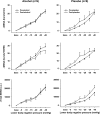Influence of acute alcohol ingestion on sympathetic neural responses to orthostatic stress in humans
- PMID: 21325108
- PMCID: PMC3093974
- DOI: 10.1152/ajpendo.00674.2010
Influence of acute alcohol ingestion on sympathetic neural responses to orthostatic stress in humans
Abstract
Acute alcohol consumption is reported to decrease mean arterial pressure (MAP) during orthostatic challenge, a response that may contribute to alcohol-mediated syncope. Muscle sympathetic nerve activity (MSNA) increases during orthostatic stress to help maintain MAP, yet the effects of alcohol on MSNA responses during orthostatic stress have not been determined. We hypothesized that alcohol ingestion would blunt arterial blood pressure and MSNA responses to lower body negative pressure (LBNP). MAP, MSNA, and heart rate (HR) were recorded during progressive LBNP (-5, -10, -15, -20, -30, and -40 mmHg; 3 min/stage) in 30 subjects (age 24 ± 1 yr). After an initial progressive LBNP (pretreatment), subjects consumed either alcohol (0.8 g ethanol/kg body mass; n = 15) or placebo (n = 15), and progressive LBNP was repeated (posttreatment). Alcohol increased resting HR (59 ± 2 to 65 ± 2 beats/min, P < 0.05), MSNA (13 ± 3 to 19 ± 4 bursts/min, P < 0.05), and MSNA burst latency (1,313 ± 16 to 1,350 ± 17 ms, P < 0.05) compared with placebo (group × treatment interactions, P < 0.05). During progressive LBNP, a pronounced decrease in MAP was observed after alcohol but not placebo (group × time × treatment, P < 0.05). In contrast, MSNA and HR increased during all LBNP protocols, but there were no differences between trials or groups. However, alcohol altered MSNA burst latency response to progressive LBNP. In conclusion, the lack of MSNA adjustment to a larger drop in arterial blood pressure during progressive LBNP, coupled with altered sympathetic burst latency responses, suggests that alcohol blunts MSNA responses to orthostatic stress.
Figures




References
-
- Eisenhofer G, Johnson RH. Effect of ethanol ingestion on plasma vasopressin and water balance in humans. Am J Physiol Regul Integr Comp Physiol 242: R522–R527, 1982 - PubMed
-
- Fagius J, Karhuvaara S. Sympathetic activity and blood pressure increases with bladder distension in humans. Hypertension 14: 511–517, 1989 - PubMed
Publication types
MeSH terms
Substances
Grants and funding
LinkOut - more resources
Full Text Sources

